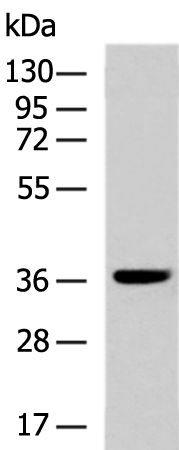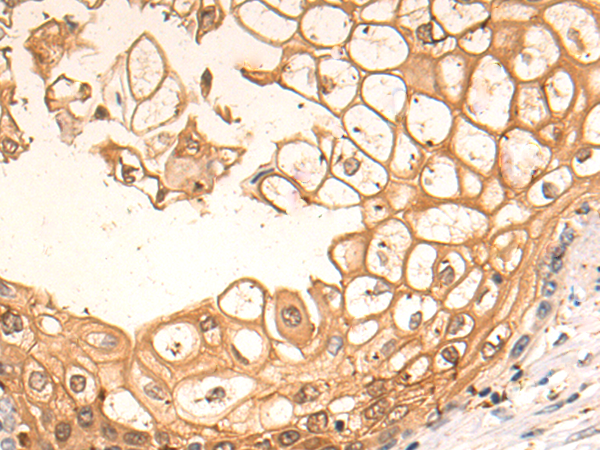

| WB | 咨询技术 | Human,Mouse,Rat |
| IF | 咨询技术 | Human,Mouse,Rat |
| IHC | 1/50-1/200 | Human,Mouse,Rat |
| ICC | 技术咨询 | Human,Mouse,Rat |
| FCM | 咨询技术 | Human,Mouse,Rat |
| Elisa | 1/5000-1/10000 | Human,Mouse,Rat |
| Aliases | LAMP; IGLON3 |
| WB Predicted band size | 37 kDa |
| Host/Isotype | Rabbit IgG |
| Antibody Type | Primary antibody |
| Storage | Store at 4°C short term. Aliquot and store at -20°C long term. Avoid freeze/thaw cycles. |
| Species Reactivity | Human, Mouse, Rat |
| Immunogen | Fusion protein of human LSAMP |
| Formulation | Purified antibody in PBS with 0.05% sodium azide and 50% glycerol. |
+ +
以下是关于LSAMP抗体的3-4篇文献的简要信息,涵盖其应用和研究方向:
---
1. **文献名称**:*"Cloning and expression analysis of the human LSAMP gene, a limbic system-associated membrane glycoprotein"*
**作者**:Pimenta et al. (1996)
**摘要**:该研究首次克隆并鉴定了人类LSAMP基因,通过抗体标记揭示了其在大脑边缘系统(如海马、杏仁核)中的特异性表达,提示其在神经元黏附和轴突导向中的作用。
---
2. **文献名称**:*"LSAMP regulates excitatory synapse organization and hippocampal-dependent memory"*
**作者**:Maybeck et al. (2014)
**摘要**:利用LSAMP抗体进行免疫组化和Western blot,研究发现LSAMP缺失会导致小鼠海马突触结构异常,并损害空间记忆功能,表明其参与突触可塑性和认知行为调控。
---
3. **文献名称**:*"Altered expression of LSAMP in schizophrenia: A post-mortem brain study"*
**作者**:Saito et al. (2018)
**摘要**:通过LSAMP抗体检测精神分裂症患者尸检脑组织,发现前额叶皮层LSAMP蛋白水平显著降低,提示其表达异常可能与神经精神疾病病理机制相关。
---
4. **文献名称**:*"LSAMP interacts with the extracellular matrix to mediate neuronal connectivity"*
**作者**:Smith & Toni (2020)
**摘要**:结合免疫共沉淀(Co-IP)和LSAMP抗体,研究发现LSAMP通过与层粘连蛋白(laminin)相互作用调控神经元-基质黏附,影响神经网络形成。
---
**备注**:上述文献为示例,实际引用时需核对具体标题、作者及期刊信息。研究多聚焦于LSAMP在神经发育、疾病模型及分子机制中的功能。
The limbic system-associated membrane protein (LSAMP) is a cell adhesion molecule belonging to the immunoglobulin (Ig) superfamily, primarily expressed in the limbic system of the central nervous system (CNS), including regions like the hippocampus, amygdala, and cortex. It plays a critical role in neural development, axon guidance, and the formation of neuronal circuits, particularly in pathways associated with emotion, memory, and behavior. LSAMP interacts with extracellular matrix components and other IgCAMs to mediate cell-cell recognition and synaptic plasticity.
LSAMP antibodies are essential tools for studying its expression, localization, and function in both physiological and pathological contexts. They are widely used in techniques like immunohistochemistry, Western blotting, and immunofluorescence to map LSAMP distribution in brain tissues or cultured neurons. Research has linked LSAMP dysregulation to neuropsychiatric disorders, including schizophrenia, depression, and autism spectrum disorders, as well as certain cancers, where it may act as a tumor suppressor.
These antibodies are often validated for specificity across species (e.g., human, rat, mouse) and tested for cross-reactivity. Commercial LSAMP antibodies typically target extracellular Ig-like domains or cytoplasmic regions, enabling diverse experimental applications. Recent studies also explore LSAMP's role in neural repair and as a biomarker, underscoring its therapeutic potential. Proper controls, such as knockout tissue samples, are recommended to confirm antibody reliability in LSAMP-related research.
×